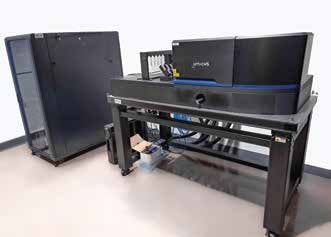
Microscope: Lumicks Optical Tweezer
Correlative force-fluorescence microscopy system that allows simultaneous manipulation and visualization of dynamic single-molecule interaction
LOCATION
Anderson Biology 108
PRICING
Rice User Fee: $20/hr
Non-Profit Fee: $31.30/hr
For Profit Fee: $100/hr
Rice Training Fee: $40/hr
Non-Profit Training Fee: $62.60/jr
For Profit Training Fee: $200/hr
CONTACTS
Training Contact:
Subash Godar: sg165@rice.edu
The instrument training is divided into 3 sessions. No prior experience in fluorescence microscopy or spectroscopy is required for the training.
Session I: 2-3 hours session consisting of presentation on basic theory and system walkthrough followed by TIRF and IRM-based imaging demonstration using standard Tetraspeck nanobeads.
Session II: 4 hours of hands-on training on microfluidics use, dual and Q traps. The session will cover force data acquisition, visualization, and analysis using a Lambda DNA tethered between two beads in a dumbbell configuration.
Session III: 2-3 hours of supervised practice with dual traps for the user. This session will also cover project discussions and experiment design of the users.
Note: Additional training sessions may be required by the instrument manager depending on the research needs before the user is allowed to work independently on the instrument. For effective learning, the users are recommended to complete all 3 sessions of training within 2 weeks. Additionally, a training video will also be provided to the user.
Faculty in Charge:
Sibani Lisa Biswal: biswal@rice.edu
DESCRIPTION
The Lumicks C-Trap is a correlative force-fluorescence microscopy system that allows simultaneous manipulation and visualization of dynamic single-molecule interaction. A unique combination of multi-trap optical tweezers, multi-color, and label-free imaging modalities, and a microfluidic device enables high throughput spatiotemporal manipulation, measurement, and visualization of diverse biophysical processes. The C-tap has a powerful (1064 nm, 20 W) trapping laser and uses a high NA objective lens (WI NA 1.3 and OI 1.49) to generate up to four simultaneous, continuous-wave optical traps. The stiffness and position of each optical trap can be controlled independently to provide maximum flexibility to the user such that a wide range of single-molecule experiments can be performed. The trap can be manipulated with an extremely high position accuracy (<0.2 nm step size) that ensures the user can perform force-distance, constant distance, and constant force measurements with a Brownian-noise limited accuracy. The C-Trap is equipped with dedicated fluorescence microscopy capabilities enabling a correlated, precise, and stable sample manipulation, force measurement, and single-fluorophore detection. TIRF microscopy offers single molecule fluorescence imaging at the surface with a high background rejection resulting in a high fluorescent signal-to-noise ratio. The platform also includes a bright-field microscope for simultaneous accurate live bead-tracking. The C-Trap includes a microfluidics solution that facilitates repeatability in single-molecule experiments in a laminar flow environment. The microfluidic flow cell provides multiple adjacent laminar flow channels that do not mix. Samples are connected to a specific channel in the flow cell and can be independently switched on and off through automated fluidic valves. The lack of actual physical barriers between adjacent channels enables users to swiftly move the trapped objects across the channels, form in-situ assembly of single molecules, and carry out experiments under different buffer conditions. FEATURES: Traps: 4 independently steerable traps with higher force resolution (<0.1 pN @ 100 Hz) and stability (<0.3 pN over 2 minutes) facilitates flexible molecular configurations. The trap can be operated as a force clamp with a maximum escape force of >1000 pN and is equipped with temperature control module (room temperature to 45 ͦC). Both the surface and solution-based experiments streamlined by a high-resolution piezo-controlled nano stage and a 5-channel µ-Flux laminar microfluidics system. Custom-prepared chambers on a glass slide can also be used. TIRF: Offers single-molecule fluorescence imaging (488 nm, 561 nm, and 638 nm laser lines) with a high background rejection. CMOS camera detector (Peak QE 95%) with the complete area of interest captured simultaneously, providing a fast video rate imaging (> 25 Hz) solution for fluorescent single molecule surface assays. Widefield (HILO): Switchable between TIRF and Hilo (dirty TIRF) modes to facilitate both single molecule surface assays as well as dumbbell constructs in the sample volume. IRM (Interference Reflection Microscopy): Label-free 3D imaging allows image acquisition of nanoscopic objects on the surface at a higher rate (25 fps @ 10 frames avg). Bluelake: Compact, integrated control software that facilitates a fully correlated data visualization and acquisition. Lakeview: Simplified and readily available data visualization and analysis software platform (download Lakeview program). The users could also export the data and perform the visualization/analysis using Pylake, a Python-based package.
ADDITIONAL INFORMATION
APPLICATIONS Protein structure-function correlation: Out of equilibrium multi-domain protein folding and conformational dynamics of protein-protein interactions using dual trap Nucleotide dynamics and small molecules/proteins binding: Localization and dynamics of DNA binding proteins, including Cas9 and CMG Helicase, during DNA editing, repair, and transcription, small molecule mediated RNA switching mechanism, and gene regulation using dual trap and TIRF. Cytoskeletal filaments and associated proteins: Microtubule and Actin filament dynamics, force generation, processivity, and regulation of cytoskeletal motor proteins, including dynein and kinesin, and their cargo transportation activities. Soft matter: Assembly, manipulation, and characterization of colloidal material, thermally mediated aggregation of colloids and suspensions, surface-mediated protein adsorption, and unfolding. Phase separation: Characterization of the phase behavior of protein droplet fusion and protein droplets condensates Microrheology: Viscoelastic properties of an active actin filament or microtubule networks. Probe the viscoelastic behaviors of the cell interior and simultaneously change the extracellular environment to study the effect of drugs in real-time. Membrane mechanics: Use functionalized beads to pull a membrane tether to measure the relation between membrane composition, curvature, tension, electrostatic distribution, and mechanics.
